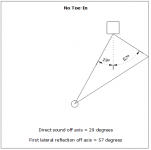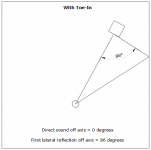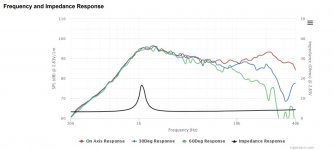I would like to put this up to discussion, because there may just be something that I don't understand.
I believe I have a sweet spot for 8" full-range or mid-range drivers in a 3-way setup. Being fairly new to this, I came across the "beaming" issue that is often expressed, which is more of a problem the larger the driver gets.
One article I came across on this topic is from Troels Gravesen, which I believe is a well respected speaker designer:
beaming
Now here is what I don't quite get: He talks about how a 60° off-axis response influences the FR of an 8" driver. The problem is obvious, yes. But, why care? Even if I would not toe-in my speakers at all, how likely is it that I listen to my music at 60° off-axis? And even if I did, most music material is more or less equal in both channels, so if I am off-axis 60° from one speaker, I am probably at nearly 0° to the other.
I am not here to say that beaming is not an issue. But to look at 60° off-axis responses to me appears to make no sense.
Or am I missing the point somehow?
I believe I have a sweet spot for 8" full-range or mid-range drivers in a 3-way setup. Being fairly new to this, I came across the "beaming" issue that is often expressed, which is more of a problem the larger the driver gets.
One article I came across on this topic is from Troels Gravesen, which I believe is a well respected speaker designer:
beaming
Now here is what I don't quite get: He talks about how a 60° off-axis response influences the FR of an 8" driver. The problem is obvious, yes. But, why care? Even if I would not toe-in my speakers at all, how likely is it that I listen to my music at 60° off-axis? And even if I did, most music material is more or less equal in both channels, so if I am off-axis 60° from one speaker, I am probably at nearly 0° to the other.
I am not here to say that beaming is not an issue. But to look at 60° off-axis responses to me appears to make no sense.
Or am I missing the point somehow?
Hi,
For stereo reproduction it is usually assumed you are at the apex of an equilateral triangle and your loudspeaker at the two other.
With 60* coverage you limit a lot of the reflections from the most adjacent wall of each loudspeakers.
For stereo reproduction it is usually assumed you are at the apex of an equilateral triangle and your loudspeaker at the two other.
With 60* coverage you limit a lot of the reflections from the most adjacent wall of each loudspeakers.
Short answer - you do not only listen to direct sound. This is not an issue so long as the direct and reflected sound are similar. But when the off axis response contour is notably different than the on-axis curve, reflected sound doesn't 'match' psycho-acoustically the direct sound.
Long answer - read and digest this:
Speaker off axis response: psychoacoustic and subjective importance - Acoustic Frontiers
Beyond that, dig into the research done by Floyd Toole and Sean Olive, and the spinorama test they developed.
Long answer - read and digest this:
Speaker off axis response: psychoacoustic and subjective importance - Acoustic Frontiers
Beyond that, dig into the research done by Floyd Toole and Sean Olive, and the spinorama test they developed.
So you are saying that the problem is that I have less reflected sound from an 8", and therefore an overall reduced FR in the upper end? So it's about the reflections rather than the "direct" sound wave?
Thanks, I will digest.Short answer - you do not only listen to direct sound. This is not an issue so long as the direct and reflected sound are similar. But when the off axis response contour is notably different than the on-axis curve, reflected sound doesn't 'match' psycho-acoustically the direct sound.
Long answer - read and digest this:
Speaker off axis response: psychoacoustic and subjective importance - Acoustic Frontiers
Beyond that, dig into the research done by Floyd Toole and Sean Olive, and the spinorama test they developed.
Depends on the room you want to work in. If your walls and ceiling are treated to absorb everything, then the off axis response isn't very important, as it would get absorbed. This is sort of a recording studio setup. Minimizing the room influence on the sound. This is where the speakers present a window into the room that the recording was made. If you are looking to create a performance in your room, wide dispersion speakers and reflective walls etc are needed. This calls attention to the speaker locations and having a frequency response that is nearly the same at all angles helps with the illusion that the performer is in your room. Works well for chamber music or old dual mono recording like the Beatles made. Floyd Toole wrote a great book on the topic, Sound Reproduction. He summarizes years of research at Harmon.
Yes, you are missing the point. We may be listening on axis, but we do not only hear what is on axis. We hear first arriving signal, then few tens of milliseconds later we receive reflected signal, of axis. The signal which traveled from those 40-60 degree angles reflected from the walls, floor and ceiling. If that signal is significantly different, out brain has to work harder, and gets tired sooner. Speakers with significantly different on axis and of axis response do not sound natural to me, even worst is with abrupt narrowing and widening the of axis response.
I got some beaming mentioned on my pages, under full range with tweeter...
I got some beaming mentioned on my pages, under full range with tweeter...
Bang & Olufson have a nice white paper about this that was published when they created their huge variable directivity speaker a couple of years back, the Beo-90?
OK, I see I was missing the point, which is the point of reflected sound...
A related question: Does this equally apply to dipole speakers?
A related question: Does this equally apply to dipole speakers?
Yes.
Dipole reflect opposite polarity backward. This is a bit more complicated than monopole but they add ambiance to the direct recorded signal. It give a nice feeling with acoustic music.
Dipole reflect opposite polarity backward. This is a bit more complicated than monopole but they add ambiance to the direct recorded signal. It give a nice feeling with acoustic music.
The situation is easy to demonstrate. Sit in your listening chair and listen for a bit. Then hold a pillow a few inches from your face to block direct sound from the speakers. Notice that the sound level you hear hardly drops at all! Direct sound strongly determines where you sense the sound is coming from, but sound over quite a few milliseconds is what you hear.
Constant directivity is generally advantageous for the reasons previously noted, dipoles are a good version because they reduce the level of early reflections.
With a fairly flat on-axis response, the off-axis frequency response will naturally be more attenuated usually above 2kHz or so. The issue occurs when you have a dip, then a rinse, then a fall, or a camel hump in the off-axis response. This may easily occur when crossing over say a 10" woofer to a 1" dome tweeter at 3 to 4 kHz. In the reflected power response, you'll get a dip centered around 1 to 2 kHz, and a hump centered around 6 to 8 kHz.
Last edited:
I had similar/related question so glad someone asked the question. I understand the reasoning now.
Don't mean to hijack the thread, but think this question is related.
I was looking at 3/4" tweeters and was comparing off axis frequency response of Dayton Audion ND20FB-4 other tweeters. See attached images. The ND20FB is very well behaved with clean sloping lines. Where as Peerless OX20SC02-04 has not so clean curves, if we only looking upto 20KHz. Other tweeters show same response, not just picking on OX20SC02.
Why would you pick OX20SC02s over ND20FB? Only reason I can think of power output 80W vs 15W. But if 15W is enough, then at least with respect offaxis response ND20FB is clear winner. Both tweeters are in similar price range.
Am I missing something?
Don't mean to hijack the thread, but think this question is related.
I was looking at 3/4" tweeters and was comparing off axis frequency response of Dayton Audion ND20FB-4 other tweeters. See attached images. The ND20FB is very well behaved with clean sloping lines. Where as Peerless OX20SC02-04 has not so clean curves, if we only looking upto 20KHz. Other tweeters show same response, not just picking on OX20SC02.
Why would you pick OX20SC02s over ND20FB? Only reason I can think of power output 80W vs 15W. But if 15W is enough, then at least with respect offaxis response ND20FB is clear winner. Both tweeters are in similar price range.
Am I missing something?
Attachments
- Home
- Loudspeakers
- Multi-Way
- Why care about 60 degree off-axis response?



